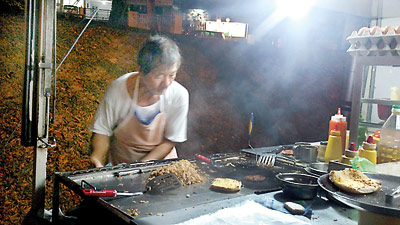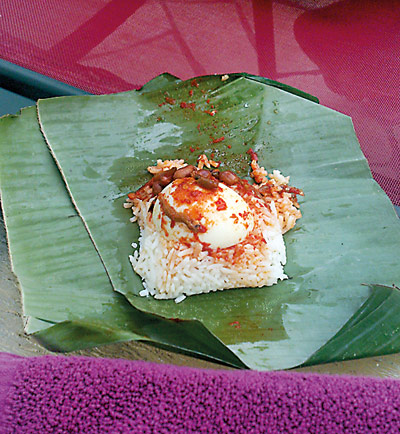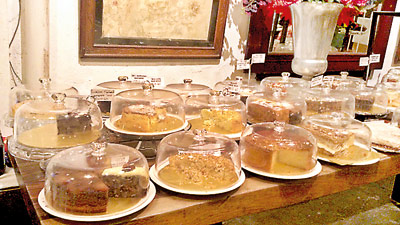Savouring a gourmet trail in Penang

The much-patronised burger-man
The Chief Executive Officer of several IT companies travels more than 350km at least once in two weeks on business to Penang, the sun-kissed beautiful island set amidst turquoise seas off Peninsular Malaysia.
However tired or stressed he may be, come supper-time which could be any time between dinner and the crack of dawn, he gets back into his sleek vehicle and manoeuvres the numerous bends down a hill, with a sharp drop to the sea on one side, from his hotel.
Peering in the dark into parking bays, as soon as he spots a wizened old man with smoke rising around him, there is a look of satisfaction. This is even before he has tasted what is on offer.
The most succulent burger that he has ever-eaten, beating by a wide margin the varied kinds on offer at all the fast food franchise chains which spend millions on advertising. Coming across it by chance when he was on a trip to Penang with his batch-mates long years ago, the lure of this burger has not diminished.
This becomes the highpoint in the tantalizing food tour of Penang that we are taken on during a recent visit there.
Not to be distracted from his dedication to making burgers at his roadside truck, while a straggly queue forms along the pavement, it is his wife who responds to my queries with one or two-word answers, for she too is busy attending to the burger-demands of the night.

Nasi lemak
More than 50 years, they have been doing the burger business, she says, adding that it was launched long before the Royal Australian Air Force (RAAF) came to Penang. (A web search indicates that when the Royal Air Force closed its station at Butterworth, which is directly opposite Penang, this location became home to the RAAF in 1957.)
All the while our eyes are drawn to the deft movement of hands and fingers of her husband who lightly toasts the bun before turning the moist and succulent patty which could either be chicken or beef, this way and that with a spatula, keeping that aside and then breaking an egg with the yolk intact and spreading it lightly onto the hot surface of his work-table before wrapping the patty with the egg. His wife, meanwhile, has buttered the toasted bun, placing slices of cucumber, tomato and cheese on it. The moment the patty is sandwiched in the bun, their signature ‘addition’ is generously piled on from a mound heaped high on the side of the work-table. What takes this street-side burger to a niche of its own, way above the brands touted across the world is not only the whole combination of the burger but also the texture of the onions caramelized just right.
Our gastronomical tour though had begun much earlier at the entry to the 13.5km bridge across the sea linking the mainland of Malaysia to Penang.
It is to a Chinese restaurant that we walk in to lunch on rice, bean-curd, Assam-style fish, served as a whole, tantalizing the taste-buds with its sour, salty, sweet and spicy flavours, prawns and beef more like the Sri Lankan Chinese dishes, roasted pork trotters and asparagus.
Driving into George Town in Penang later, we quench our thirst with delicious Cendol (pronounced chendol) from a cycle-cart down a hawker street, where too the queue snakes onto the main road. Cendol is a simple concoction of coconut milk in which float gula melaka (chunks of jaggery), noodle-like green jelly pieces, sweetened kidney beans, topped up with ice shavings and is slurped off like soup from small bowls with spoons.
Galore are the other cycle-carts vending a variety of foods including the Malaysian staple of fried kway teow (noodles) and fried rice and rojak which is fruit and vegetables with raw guava, mangoes and green apples in a sweet but spicy, thick and toffee-like peanut dressing. A favourite with one of my nieces was the fried yam sandwich – two pieces of yam generously slathered with kaya, a jam made from coconut milk, eggs and sugar, dipped in dough and fried.
In the morning, nay any time of the day, another staple seems to be nasi lemak, with another niece explaining that ‘nasi’ simply means ‘rice’. Like our very own kiri-buth (milk-rice), but slightly drier, it is served in a bungkus (cone or gotta) with a flaming chillie and onion sambal, fried peanuts and anchovies, a slice of boiled egg and slices of cucumber as accompaniments.
Of course, after the terrifying funicular train-ride up Penang Hill, while facing the chilly gusts of wind and spectacular view spread below, a must-have is coconut ice-cream to calm the nerves and prepare you for the downward trip, screaming in fear, especially if you have secured the much vaunted front carriage.

The delicious cakes of ChinaHouse
It is a different kind of luncheon that we sit down to thereafter – walking into the kitchen off a main road to order our choice of food and then two shops down into the restaurant to take our seats. Here we tuck into nasi kandar (what we call biriyani) cooked to a 109-year-old original recipe at Hameediyah’s.
Be it chicken, lamb, beef or squid, huge pieces are enfolded within soft long grains of rice, flavoured and cooked to perfection, with the side-dishes being stir-fried carrots and cabbage and pickled cucumber and pineapple.
Two doors from Hameediyah’s, once again down an alleyway turned into a food stall, we stop for iced kopi (you guessed right – locally brewed coffee) not served in cups but in large mugs. Frequented by the Chief Minister of Penang for a quick bite of breakfast, locals vouch that this food stall serves the best roti bakar (toasted bread) with butter and kaya.
Evening sees us trudging to Chew Jetty where several cycle-hawkers selling different types of food and drink share a common area in which their clientele can occupy a table and indulge in a meal. It is a mix of noodles and rice that we dine on here, including prawn mee (noodles in a spicy broth), loaded with prawns, shredded chicken, slices of fish balls, bean sprouts and lots of condiments; kway teow goreng which consists of stir-fried flat noodles with bean sprouts, chicken, prawn, pork and vegetables; and wan tan mee, noodles cooked in soya sauce with slices of roast pork and dumplings, followed by a fruit dessert of longan of the lychee family.
The next night, our dinner is a super luncheon meat burger, followed in quick succession with roti canai (like our godamba rotti) in a stall off the main road, prepared by a smiling middle-aged Indian with a twinkling nose-stud. Her culinary skills produce ‘breads’ in all their variety including chapatti, dosa and roti canai as soon as the orders flow forth to be dipped in out-of-this-world chicken, sardine or dhal curry. The meal is rounded off with a steaming roti pisang (a godamba rotti filled with banana and honey) which is a heavenly ‘dessert’.
Not content yet that we have savoured adequately of the foods of Penang, we pass blocks of street art including sketches and sculptures of sorts to enter the very long but narrow ChinaHouse, with one end being the café and the other end the pub. Consisting of three heritage buildings the ‘icing’ at ChinaHouse is its bakery with its thick, delicious slices of cake, washed down with steaming cups of tea or hot chocolate.
Our gourmet trail ends the following day with a spread of authentic ‘Chinese’ cuisine – suckling pig, roast duck, beef with a type of green leaf we cannot identify, prawn in gravy (reminding us of kiri hodi), bean-curd and brinjal (aubergine).
A never-to-be-forgotten food trail that has left us yearning for more but with a distinctly thicker waistline!


